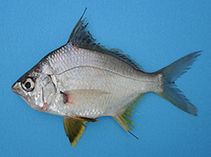| Family: |
Gerreidae (Mojarras) |
| Max. size: |
38 cm TL (male/unsexed) |
| Environment: |
demersal; brackish; marine |
| Distribution: |
Eastern Pacific, tropical, western coast of Baja California (Bahia Magdalena), including Gulf of California, south to nothern Peru. |
| Diagnosis: |
Dorsal spines (total): 9-9; Dorsal soft rays (total): 10-10; Anal spines: 3-3; Anal soft rays: 8-8. Distinguished by having serrated posterior and inferior margins of preopercular bones; smooth preorbital (lachrymal); sometimes with fine serrations on jugal (infraorbital ); pointed or pinniform pharyngeal teeth; rudder-shaped urohyal bone (Ref. 75986). |
| Biology: |
Occurs in bays, estuaries, and coastal lagoons bordered by mangroves, over sandy or muddy bottoms; usually enters continental waters. Carnivorous, based on reported consumption of benthic organisms of copepods, ostracods, foraminifera, sponges, polychaetes, and molluscs, fishes, and aquatic vegetation (Ref. 75986). |
| IUCN Red List Status: |
Not Evaluated (N.E.) Ref. (130435)
|
| Threat to humans: |
harmless |
Source and more info: www.fishbase.org. For personal, classroom, and other internal use only. Not for publication.
